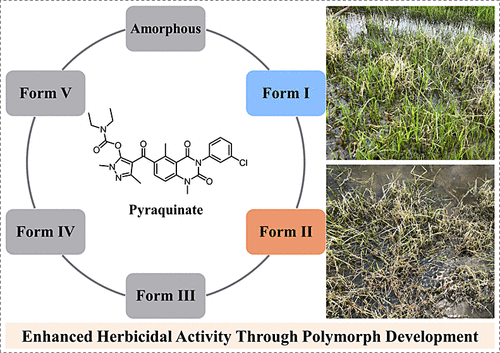
Developing more efficient and greener pesticides has been one of the top goals of the modern chemical industry. Only recently, the role of crystal chemistry has been considered for optimizing the performance of contact insecticides, which requires direct contact between toxic crystals and insects. In addition, it was found that crystal forms with higher thermodynamic free energies yield better insecticidal activity and may ever overcome insecticide resistance in mosquitoes.
Given the importance of polymorphism in boosting the activity of contact insecticides, for herbicides, the substances used to control undesired weeds, there is a notable absence of literature exploring the connection between polymorphs and bioactivities. This oversight likely stems from the prevailing assumption that herbicides are primarily used as aqueous solutions rather than solid phases, thereby diminishing the perceived relevance of solid-state chemistry considerations. However, given that most commercially available herbicidal compounds exhibit limited solubility in water, their application in the field as highly diluted suspensions results in the deposition of herbicidal active ingredients as minute crystals on leaf surfaces. The existence of a direct crystal-plant contact means that the solid state of herbicides could potentially play a role in their effectiveness. Thus, it is imperative to investigate the polymorphism of herbicides more thoroughly to understand how it might impact their performance under real-world conditions.
Pyraquinate(4-{[3-(3-chlorophenyl)-1,5-dimethyl-2,4-dioxo-1,2,3,4-tetrahydroquinazolin-6-yl]carbonyl}-1,3-dimethyl-1H-pyrazol-5-yl diethylcarbamate, CAS No. 2378093-62-8), a newly developed broad-spectrum herbicide with no reported polymorph, was selected as model compound. As an effective 4-hydroxyphenylpyruvate dioxygenase (HPPD, EC 1.13.11.27) inhibitor, pyraquinate showed great performance against a wide range of weeds, such as Leptochloa chinensis, Echinochloa crusgalli, Digitaria sanguinalis, and so on, while remains exceptional safety for rice cultivation. When applied, pyraquinate inhibits the activity of HPPD, which is crucial for the photosynthesis of plants, leading to the bleaching and eventual death of weeds. However, controlling resistant Echinochloa crusgalli, common in rice fields, requires a high application dosage, potentially posing additional environmental risks.
Recently, Jingxiang Yang’s group have presented the first observation of the polymorphism-dependent bioactivity of herbicides, underscoring the significance of prior knowledge of polymorphism for maximizing the practical benefits and potential of pesticides with practical benefits. Five polymorphs and an amorphous solid of pyraquinate, an HPPD inhibitor, have been prepared and characterized during our attempt to improve the efficacy of this newly developed herbicide. The crystal structures of Forms I, II, IV, and V were determined by single crystal X-ray analysis. The relative stabilities of the five polymorphs were deduced from thermal behaviors and solid-state phase transformations. Forms I and II were found to be enantiotropically related, with Form II being thermodynamically metastable at room temperature and 1.5 times more soluble than Form I. The newly discovered Form II proved to be more effective against resistant Echinochloa crusgalli than the commercialized Form I in both greenhouse bioassays and field trials. Additionally, Form II is easy to prepare and kinetically stable against transformation in water or oil-based suspension concentrates, making it a promising candidate for improved weed control with a reduced environmental footprint. The studies on the reactivity of silanone 2 indicated its rich chemistry, which could be further explored. Relevant achievements were published in Cryst. Growth Des., 2024, DOI: 10.1021/acs.cgd.4c00831.